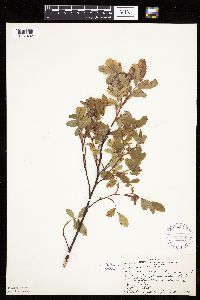Rosa blanda
|
|
|
|
Family: Rosaceae
Smooth Rose
[Rosa acicularioides Schuette, moreRosa blanda f. carpohispida (Schuette) W. H. Lewis, Rosa blanda var. alba Schuette ex Erlanson, Rosa blanda var. setigera Crép., Rosa fraxinifolia Borkh., Rosa solandri Tratt.] |
Colony-forming shrub to 2 m tall Stem: slender, brown, hairless, lacking prickles or with few to many slender straight prickles near base and beneath stipules. Flowering branches and new growth are more or less prickleless. Leaves: pinnately compound, hairy-stalked, main axis (rachis) usually hairy, usually with five or seven leaflets. The leaflets are dull pale green and hairless above, paler and usually softly hairy beneath, 2 - 6 cm long, narrow elliptic-oblong to oval or inversely egg-shaped with a blunt to pointed tip, and toothed. Flowers: borne solitary or arranged in nearly flat-topped clusters (corymbose) on lateral branches of previous year's stems, 4 - 6 cm across, with a hairless stalk and floral tube (hypanthium), 1 - 2 cm long persistent sepals that are erect and come together in fruit, and pink petals 2 - 3 cm long. Fruit: bony achenes surrounded by the mature floral tube (hip). The hip is red, 8 - 15 mm across, nearly spherical to egg-shaped or inversely egg-shaped with an erect beak of sepals. Achenes are elliptic-egg-shaped and 4.5 - 5 mm long. Stipules: subtending leaves, enlarged, non-toothed (rarely glandular-toothed), usually softly hairy to nearly hairless. Similar species: Rosa acicularis, R. arkansana var. suffulta, R. blanda, and R. cinnamomea have hairless flower stalks and floral tubes and erect, persistent sepals. Rosa acicularis differs by having glandular stipules and stems that are prickly throughout. Rosa arkansana var. suffulta usually has nine leaflets and stems that are prickly throughout. Rosa cinnamomea is distinguished by its coarse, stout, recurved prickles subtending the stipules. Flowering: mid May to late June Habitat and ecology: Railroad embankment slopes, deposits of soil from excavation, wooded ravines, and fens. Occurence in the Chicago region: native Etymology: Rosa is the Latin name for a rose. Blanda means mild, referring to its lack of prickles. Author: The Morton Arboretum Colonial; stems to 1.5 or 2 m, unarmed or with few to many slender prickles toward the base, these not extending onto the flowering branches; stipules entire to glandular-dentate; lfls mostly 5 or 7, narrowly elliptic-oblong to oval or obovate, to 5 cm, coarsely toothed, especially above the middle; fls solitary or corymbose on lateral branches from stems of the previous year; pedicels and hypanthium glabrous; sep persistent, usually erect and connivent after anthesis; pet pink, 2-3 cm; hips red, 8-15 mm thick; 2n=14. Dry woods, hills, prairies, and dunes; Que. to Man., s. to N.Y., Pa., Ind., and Mo. (R. subblanda) The stipules, rachis, and lower lf-surface are usually softly hairy or tomentulose. A striking form found along the shores of the Great Lakes, with glabrous stipules and rachis, and small, firm, glabrous lfls, may be worthy of varietal recognition. R. johannensis Fernald, occurring from Que. to Me. and n. N.Y., may represent another var., or possibly it may reflect hybridization with another sp. The lvs are glabrous or nearly so, and the persistent sep are reflexed. Gleason, Henry A. & Cronquist, Arthur J. 1991. Manual of vascular plants of northeastern United States and adjacent Canada. lxxv + 910 pp. ©The New York Botanical Garden. All rights reserved. Used by permission. From Flora of Indiana (1940) by Charles C. Deam This species is, for the most part, restricted to the area about Lake Michigan where it is found in the low, interdunal flats and up to the very tops of the highest dunes. On account of many visitors to the high dunes it has already almost disappeared from this habitat. I have it also from Elkhart County and Grimes found it along the railroad in Putnam County where it was a migrant. It is possible that this rose may yet be found in more of our northern counties, especially in La Porte and St. Joseph Counties. For a more detailed discussion of this and other species of Indiana roses, see Deam, Shrubs of Indiana, ed. 2. Indiana has the following named varieties: [Variety carohispida] with stipitate glands on the hypanthium. This is a rare form. [Variety glandulosa], with pyriform hips. I have this form from Porter County, and it has been reported from the dunes by Peattie. [Variety hispida] with densely bristly stems. Reported from the dune area of Lake Michigan by Peattie. …… Indiana Coefficient of Conservatism: C = 4 Wetland Indicator Status: FACU |













































































